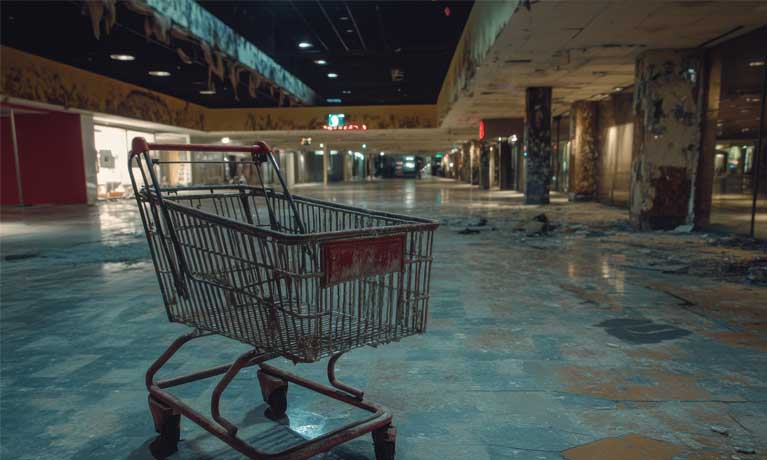By Professor Lyndon Simkin, the Centre for Business in Society at Coventry University
The High Street’s Demise
The Centre for Retail Research is predicting 17,349 shops will close in 2025. 14,660 are expected to be independent retailers. 201,953 jobs will be lost based on these forecasts.[i] According to BBC News, throughout 2024 38 shops closed per day.[ii] The majority of recent closures are pharmacies, pubs and banks, which traditionally have attracted footfall into town centres. Experts are expecting higher rates of shop closures in 2025 caused by rising NI tax rates and operating costs.[iii]
For 120 years, the march of multiple retailers, financial services, office developments, restaurants and bars, has eaten up the land within town and city centres, taken away open spaces and parks, and forced out low-yielding activities. Most residential land-use was banished, apart from low-rent poorer flats above commercial premises. The competition for retail sites priced out other users and Local Authorities focused their plans on busy city centre retailing.
Modern retailing and the dominance of large chains and retail groups emerged in the 1980s, with many retail giants seeking fast expansion of their store networks and aggressively competing for each site as it became available. Retailers could not open more stores quickly enough. That was the 1980s. Before online shopping. Now, empty retail stores may well sit unused for years; a situation which is worsening daily as first the pandemic impacted on spending patterns and then the cost-of-living crisis hit. The plain fact is that with so many buying so much online, there is no longer the footfall in the city centre to warrant as much retail space.
Repurposing Retail Land Use
Too many towns and cities are blighted with derelict retail units landlords are unable to let. BHS and Woolworths both ceased trading a decade ago, yet 40% of their large units still lie unused. The demise of Debenhams added to this blight, along with the closure of many House of Fraser department stores and even post-pandemic several branches of John Lewis. But so many other well-known brands also have ceased trading or scaled back their stores.
Oasis and Warehouse, BrightHouse and Beales department stores pulled the plug as Covid-19 struck, while fashion and household goods retailers New Look, Cath Kidston and Laura Ashley restructured and teetered, with Cath Kidston and Laura Ashley ultimately closing their stores. Even the leading lights John Lewis and M&S did not reopen all of their department stores after the lockdown measures ceased. Fast-fashion chain Peacocks called in the receivers, Ann Summers and Moss Bros closed stores, and global fashion player H&M announced the closure of 250 stores because of the pandemic. Even the once mighty Arcadia Group, operator of TopShop, Burton and Dorothy Perkins, famed for having the power to dictate to landlords the rents it was prepared to pay, fell in 2020.
Since the pandemic, the closures have continued. In 2023, Paperchase went into receivership and closed all 106 shops. All of M&Co’s 170 fashion shops closed, Clinton Cards closed a fifth of its stores, health and beauty retailer Boots closed a further 300 stores, and household goods giant Wilko declared insolvency and closed all 400 stores. Others are struggling to remain afloat; WH Smith, New Look, Select, Dobbies, Poundland, Sports Direct and others are now cutting their branches. Hospitality brands have also suffered. Carluccio’s, Byron, Café Rouge, Bella Italia, Franky & Benny’s, Chiquito, Pret, Pizza Express, Ask and Zizzi all announced closures as they fought for survival, adding more empty units to already dismal high streets.
Until Covid-19 struck, the high street’s woes largely were because of the surge in on-line shopping. The growth in digital shopping 24/7 is seemingly never-ending. Any sale executed online is one no longer provided by a retail store. Fewer visits to stores further reduces the viability of high streets generally and creates a shopping behaviour which no longer savours the sociability and leisure experience aspects of ‘going out shopping’. The statistics reveal the growth of online retailing, with a quarter of purchases now made online.[iv]
Change is Emerging
Challenging and threatening times? Or an era of new opportunities? Either way, the traditional high street cannot cling to life unaltered, as it had struggled vainly to do before the pandemic struck.
Coventry is at the forefront of the new move to ‘reframe’ our city centres and high streets. The conversion of a redundant department store in the West Orchards mall into mixed leisure, including retail, hospitality and a range of leisure distractions from bowling to crazy golf is one example of a trend emerging across the UK. Empty large stores are being repurposed. House of Fraser in Leamington is now a digital office hub, the former Debenhams store in the heart of nearby Stratford Upon Avon is being demolished to make way for a new hotel, the former House of Fraser store in neighbouring Solihull is to be demolished and transformed into an urban village.
The other way in which Coventry is at the forefront of reframing retail space is with the delayed south side regeneration plan, now starting to make progress. This huge redevelopment will see 50% of the former city centre retail area demolished, including the former sites of C&A, the Co-Op, Woolworths and the indoor market hall. The street pattern will be realigned, new open areas and leisure spaces created, and instead of retailing there will be a mixed use area of the city centre, including some retail and hospitality, much more leisure use, healthcare services, offices and a considerable amount of new residential units targeting young adults, the elderly and some family use.
Lessons Will Need To Be Learned
Who or what will be the winners and losers in this challenging period of transition for our city centres is the question. Who will provide the innovative thinking and new business models required to regenerate town and city centres is the fascination. As well as how the required levels of collaboration and agreement between vested interests will best be fostered. Change is certainly needed, but is so challenging to achieve.
There will be successes and failures to assess and learn from, and no doubt no single approach to repurposing high streets and city centres will alone be the optimum pathway.
Various options are emerging and being trialled for repurposing retail space and buildings, altering land use and shifting policy, so there is the opportunity to evaluate their merits, explore any associated problems, propose appropriate processes and models, and identify the requisites for success. It is unlikely that only one model of land re-use will be the preferred solution in all towns and cities. So what will work best and in which circumstances?
There are two sets of challenges to address: (i) wider acceptance that change of use and how planners intend to use retail space in city centres is needed now, and appreciation that different models are required; (ii) there is then the challenge for researchers to evaluate the various new-use models now emerging, to understand what is effective and what is not, under what circumstances and why. Not everything now being considered will prove successful.
Through understanding the impact of organisations’ activities, behaviours and policies, the Centre for Business in Society at Coventry University seeks to promote responsibility, to change behaviours, and to achieve better outcomes for economies, societies and the individual.
[i] Centre for Retail Research (2025), The Crisis in Retailing: Closures and Job Losses; https://www.retailresearch.org/retail-crisis.html.
[ii] BBC News (2024a), High street hit as 38 shops close every day, September 12th; https://www.bbc.co.uk/news/articles/cp35e8ggk59o.amp.
[iii] Poulter, R. (2025), Warning of mass high street shop closures as 47 set to shut every day in UK, Devon Live, January 5 2025; https://www.devonlive.com/news/cost-of-living/warning-mass-high-street-shop-9832176?int_source=nba; Saker-Clark, H. (2025), More than 13,000 high street shops closed in 2024, The Standard, January 2 2025; https://www.standard.co.uk/business/business-news/more-than-13-000-high-street-shops-closed-in-2024-b1202583.html.
[iv] Office for National Statistics (2024), Internet sales as a percentage of total retail sales; https://www.ons.gov.uk/businessindustryandtrade/retailindustry/timeseries/j4mc/drsi.




Comments are disabled